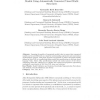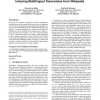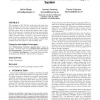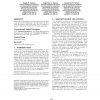JUCS
2010
14 years 14 days ago
2010
: Assessing the quality of conceptual models is key to ensure that conceptual models can be used effectively as a basis for understanding, agreement and construction of information...
WWW
2011
ACM
14 years 19 days ago
2011
ACM
We propose a description-logic style extension of OWL 2 with nominal schemas which can be used like“variable nominal classes”within axioms. This feature allows ontology langua...
WWW
2010
ACM
14 years 4 months ago
2010
ACM
With the enormous and still growing amount of data and user interaction on the Web, it becomes more and more necessary for data consumers to be able to assess the trustworthiness ...
CIKM
2010
Springer
14 years 4 months ago
2010
Springer
In recent years, a number of projects have turned to Wikipedia to establish large-scale taxonomies that describe orders of magnitude more entities than traditional manually built ...
SAC
2008
ACM
14 years 5 months ago
2008
ACM
The emergence of the Web has made more and more news items available, however only a small subset of these news items are relevant in a decision making process. Therefore decision...
I3
2007
14 years 7 months ago
2007
Referent tracking (RT) is a new paradigm, based on unique identification, for representing and keeping track of particulars. It was first introduced to support the entry and retri...
DGO
2007
14 years 7 months ago
2007
Government e-services available to citizens represent one of the most frequent and critical points of contact between public administrations and citizens. In addition to common se...
ICPW
2007
14 years 7 months ago
2007
The Rule Responder project (responder.ruleml.org) extends the Semantic Web towards a Pragmatic Web infrastructure for collaborative human-computer networks. These allow semi-autom...
ATAL
2007
Springer
14 years 9 months ago
2007
Springer
We present an argumentation-based formalism that an agent could use for constructing plans. We will analyze the interaction of arguments and actions when they are combined to cons...
INTERACTION
2009
ACM
14 years 10 months ago
2009
ACM
In this paper, we present the core concept and the benefits of an approach called RoboEarth which will be highly beneficial for future robotic applications in science and industry...




